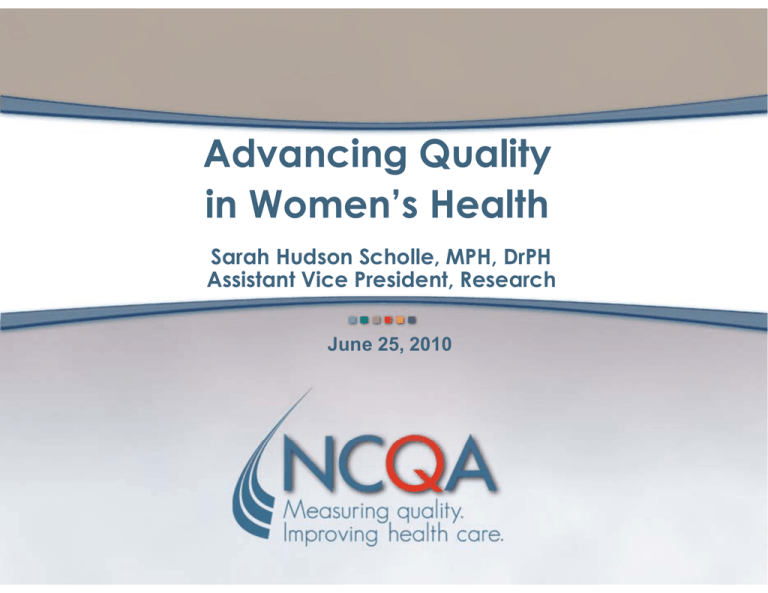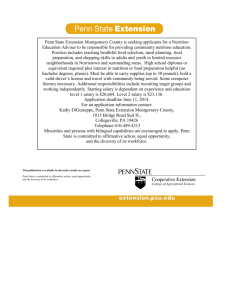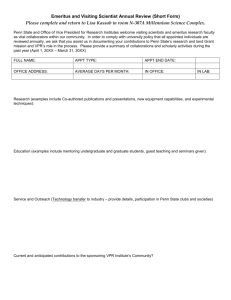Advancing Quality in Women’s Health Sarah Hudson Scholle, MPH, DrPH
advertisement

Advancing Quality in Women’s Health Sarah Hudson Scholle, MPH, DrPH Assistant Vice President, Research June 25, 2010 Agenda • NCQA • Policy P li Opportunities O t iti • Measurement Priorities – Pregnancy Care – Well Woman Care • Issues & Future Directions Penn State May 3, 2010 2 NCQA: A Brief Introduction • Private, independent p non-profit p health care quality oversight organization founded in 1990 • Committed to measurement,, transparency and accountability • Unites diverse groups around common goal: improving g p g health care q quality y Penn State May 3, 2010 3 Quality in Health Care Reform • Health Insurance Exchanges – Covers 32 Million More Nonelderly People – Accreditation and pay for performance requirements • Establish a national strategy for quality improvement by 2011 – Create benchmarks and report – Align public and private payers • Delivery system reform – Medical home – Accountable care organizations Penn State May 3, 2010 4 New Policy Directions • Child Health Insurance Program R Reauthorization th i ti Act A t – encourages g state q quality y reporting p g and new measure development, including pregnancy care • American Recovery and Reinvestment Act (ARRA) legislation – authorizes payment for meaningful use of EHR ( d th (and then penalties) lti ) Penn State May 3, 2010 5 Proposed CHIPRA Core Measures: Women & Adolescents • Adolescent Well Visits • Adolescent Immunizations • BMI Documentation • Chlamydia Screening • Timeliness of Prenatal Care • Frequency of Ongoing Prenatal Care Penn State May 3, 2010 6 Proposed Meaningful Use Measures OB-GYNs Prevention Screening Mammography Body Mass Index (BMI) Cervical Cancer Screening Chlamydia screening Prenatal Screening for Human Immunodeficiency Virus (HIV). Prenatal Anti-D Immune Globulin. Overuse Hysterectomy y y rates Cesarean Rate for low-risk first birth women Safety 30 Readmission Rate following deliveries Primary Care (Examples) Prevention o Inquiry Regarding Tobacco Use o Body Mass Index (BMI)Screening and Follow-Up o Cervical Cancer Screening o Screening Mammography o Colorectal Cancer o Influenza Immunization for Patients >= 50 Years Chronic Care o Controlling High Blood Pressure. o Diabetes: Hemoglobin A1c Poor Control o Ischemic Vascular Disease: Complete p Lipid p Profile, Low Density Lipoprotein (LDL-C) Control, o Depression: Effective Acute Phase Treatment Overuse o Low back pain: use of imaging studies. o Appropriate Testing for Children with Pharyngitis o Use of appropriate meds for people with asthma. Penn State May 3, 2010 7 Priorities for Women’s Health • Patient and Family Engagement, to provide patient-centered, i effective ff i care • Build on influence women have on the well-being and health care decision-making ii i of women/families • Population Health, to bring greater focus on wellness and prevention starting in our communities • Examine the content of care of age/life-stage appropriate preventive care rather than counting up visits • Care Coordination, to provide patient-centered, high-value care • Address women’s use of multiple providers for genderspecific and gender-neutral needs • Overuse, to remove waste, encourage appropriate use, and achieve effective,, affordable care • Assess overuse of tests and procedures,, both for maternity p y care and other services Penn State May 3, 2010 8 Improving Quality Measurement for Women’s Women s Preventive Care Project • Phase 1: Convene working meeting to prioritize measurement opportunities – Supported by CDC and HRSA (Completed in December 2009) • Phase 2: Develop and test measures – PCPI/NCQA/ACOG joint work group on pregnancy care measures Penn State May 3, 2010 9 Key Areas of Concern • Identification and management of health risks i k • Coordination of care across settings and time • Patient P ti t Engagement E t • Overuse • Outcomes Penn State May 3, 2010 10 Measurement Opportunities: Well Woman Identification and 1. Screening management of • Cancer health risks • STDs 2. BMI Assessment & Follow-up 3. Behavioral Health Risk Assessment & Follow-up p / / p g with change g • Depression/stress/coping • Substance abuse and tobacco use 4. Reproductive health • Family/reproductive life plan • Pregnancy readiness) Coordination 1. Coordination for chronic disease Patient Engagement 1. Decision support/shared decision-making 1 decision making 2. Patient access to own records 3. Health literacy O Overuse N proposed No d measure Outcomes No proposed measure Penn State May 3, 2010 11 Measurement Opportunities: Prenatal Care Identification and 1. Prenatal testing & treatment management of • HIV health risks • RH • Genetic • Gestational diabetes p 2. BMI Assessment & Follow-up 3. Behavioral Health Risk Assessment & Follow-up • Depression/stress/coping with change • Substance abuse and tobacco use Coordination 1. Planning and Care Coordination • Breastfeeding plans • Family planning • Pediatric care Patient Engagement 1. Decision support/shared decision-making Overuse No proposed measure Outcomes pp p Weight g Gain 1. Appropriate Penn State May 3, 2010 12 Measurement Opportunities: Labor & Delivery Identification and 1. Appropriate Medication During Management of Premanagement of term Labor health risks 2. Delivery at site with appropriate level of care available 3. Prophylactic Antibiotic prior to Cesarean delivery Coordination Patient Engagement 1 Prenatal record available at labor and delivery 1. No proposed measure Overuse 1. Elective Delivery Before 39 Weeks 2. Episiotomy 3. Cesarean delivery y for low-risk women Outcomes 1. Incidence of potentially preventable maternal or fetal serious adverse events during delivery 2. Normal childbirth Penn State May 3, 2010 13 Measurement Opportunities: Postpartum Identification and 1. Breastfeeding management of 2. Family planning/reproductive life plan health risks 3. Behavioral Health Risk Assessment & Follow Follow-up up • Depression/stress/coping with change • Tobacco use Coordination 1. Planning and Care-coordination • Follow up of risks identified in pregnancy • Hand-off for chronic disease management g Patient Engagement No proposed measure Overuse No proposed measure Outcomes No proposed measure Penn State May 3, 2010 14 Barriers to Improved Quality • Patient engagement – Common C definition d fi iti off “ “wellll woman”” – Views about what is a “healthy normal” birth • Silos in health care system – Lack of service integration – Challenge of linking data • System issues – Liability reform – Reimbursement Penn State May 3, 2010 15 Medical Home • Model of care that provides patientcentered, t d comprehensive, h i accessible, ibl and coordinated care and a systemsbased approach to quality and safety • First articulated in pediatrics in 1960s • Joint Principles adopted by primary care physician groups in 2008 • NCQA NCQA’ss PCMH tool is most widely used in demonstration programs with payment reform Penn State May 3, 2010 16 PCMH 2011 Overview (6 standards/24 elements) 1 1. Access and Continuity A. B. C C. D. E. F. Access During Office Hours Access After Hours Electronic Access Continuity (with provider) Patient/Family Partnership Culturally/Linguistically Appropriate Services G. Practice Organization 2. Self Management Support Self-Management A. Self-Care Process 5. Track/Coordinate Care A. Test Tracking and Follow A Follow-Up Up B. Referral Tracking and Follow-Up C. Coordination with Facilities/Care Transitions D. Referrals to Community Resources 6. Performance Measurement Identify/Manage Patient Populations /Quality Improvement A. B. C. D D. 3. 4 4. Basic i Data t Searchable Clinical Data Comprehensive Health Assessment Using Data for Population Management Plan/Manage Care A. B B. C. D. Guidelines for Important Conditions Care Management Medication Management Electronic Prescribing A. B. C. D. E. Measures of Performance Patient/Family Experience Reporting Performance Quality i Improvement Electronic Reporting Optional Patient Experiences Optional Performance Measurement Penn State May 3, 2010 17 PCMH and Women’s Health • ACOG: “women’s health homes” • Ob/gyns are seeking PCMH designation • NCQA NCQA’ss tool is silent on specialty – Open for public comment through Monday 6/28 5pm 5 Eastern E t Penn State May 3, 2010 18 Issues • Leadership • Consumer demand • Evidence E id base b • Feasibility y Penn State May 3, 2010 19 For more information: Sarah Hudson Scholle, Scholle MPH MPH, DrPH scholle@ncqa.org 202 955 1726 www.ncqa.org Penn State May 3, 2010 20








